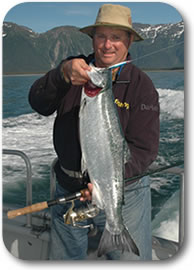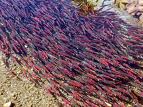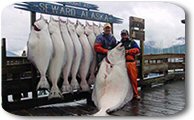Seward Alaska, located at the, Head of Resurrection Bay, is one of Alaska’s Best fishing destinations. Alaska is know for it’s world class fishing and Seward’s fishing is some of the best the state has to offer. When fishing for Silver Salmon, Halibut, Ling Cod, or Red Snapper, Seward’s Small Boat Harbor is where your fishing adventure will begins. All species of Salmon can be caught in the water near Seward during the summer months, and other Seward Fishing activities continue year round.
Chinook Salmon
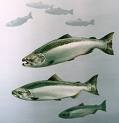
(Book your Seward Fishing trip)
Oncorhynchus tshawytscha
Other names: king salmon, tyee salmon, blackmouth salmon (immature)
Average size: 10-15 lbs, up to 135 lbs
Fall spawner; fall, spring, and summer runs
Species Description
The king or chinook salmon, is among the most coveted game fish we catch on fishing charters in Seward. The king salmon is also one of the most important sport fish on the Pacific coast. It is the largest Pacific salmon, commonly exceeding 30 pounds. The 126-pound King salmon taken commercially in 1949 is the largest on record. The largest sport caught King salmon was a 97-pound fish taken in the Kenai River in 1986. Chinook mature at about 36 inches and 30 pounds.
In Seward, Alaska only a few charter boats target local feeder King or Chinook salmon. These fish can prove elusive and catching one will provide a battle you wont soon forget on light tackle. We have found that spring and fall are the best times to fish for resident feeder king salmon in Seward. May through June provide an opportunity at catching our run of returning kings. Although good catches are made year round, the lack of light and unpredictable weather during the heart of winter shortens the fishing days. Kings are wiley and can be finicky until they get ready to feed. When that time comes, it can get fast and exciting. We have found the most productive method of catching the kings is trolling using downriggers. King salmon fishing in Seward requires patience, persistence and the coordination of the crew and fishermen. The results are well worth the effort.
Chinook salmon are very similar to coho salmon in appearance while at sea (blue-green back with silver flanks), except for their large size, small black spots on both lobes of the tail, and black pigment along the base of the teeth.
Adults migrate from a marine environment into the freshwater streams and rivers of their birth in order to mate (called anadromy). They spawn only once and then die (called semelparity).
They feed on terrestrial and aquatic insects, amphipods, and other crustaceans while young, and primarily on other fishes when older.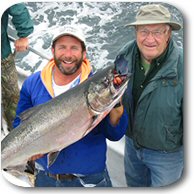
Juvenile Chinook may spend from 3 months to 2 years in freshwater before migrating to estuarine areas as smolts and then into the ocean to feed and mature. Chinook salmon remain at sea for 1 to 6 years (more commonly 2 to 4 years), with the exception of a small proportion of yearling males (called jack salmon) which mature in freshwater or return after 2 or 3 months in salt water.
There are different seasonal (i.e., spring, summer, fall, or winter) “runs” in the migration of Chinook salmon from the ocean to freshwater, even within a single river system. These runs have been identified on the basis of when adult Chinook salmon enter freshwater to begin their spawning migration. However, distinct runs also differ in the degree of maturation at the time of river entry, the temperature and flow characteristics of their spawning site, and their actual time of spawning. Freshwater entry and spawning timing are believed to be related to local temperature and water flow regimes.
Chinook salmon eggs will hatch, depending upon water temperatures, 3 to 5 months after deposition. Eggs are deposited at a time to ensure that young salmon fry emerge during the following spring when the river or estuary productivity is sufficient for juvenile survival and growth.
Two distinct types or races among Chinook salmon have evolved.
One race, described as a “stream-type” Chinook, is found most commonly in headwater streams of large river systems. Stream-type Chinook salmon have a longer freshwater residency, and perform extensive offshore migrations in the central North Pacific before returning to their birth, or natal, streams in the spring or summer months. Stream-type juveniles are much more dependent on freshwater stream ecosystems because of their extended residence in these areas. A stream-type life history may be adapted to areas that are more consistently productive and less susceptible to dramatic changes in water flow. At the time of saltwater entry, stream-type (yearling) smolts are much larger, averaging 3 to 5.25 inches (73-134 mm) depending on the river system, than their ocean-type (subyearling) counterparts, and are therefore able to move offshore relatively quickly.
The second race, called the “ocean-type” Chinook, is commonly found in coastal streams in North America. Ocean-type Chinook typically migrate to sea within the first three months of life, but they may spend up to a year in freshwater prior to emigration to the sea. They also spend their ocean life in coastal waters. Ocean-type Chinook salmon return to their natal streams or rivers as spring, winter, fall, summer, and late-fall runs, but summer and fall runs predominate. Ocean-type Chinook salmon tend to use estuaries and coastal areas more extensively than other pacific salmonids for juvenile rearing. The evolution of the ocean-type life history strategy may have been a response to the limited carrying capacity of smaller stream systems and unproductive watersheds, or a means of avoiding the impact of seasonal floods. Ocean-type Chinook salmon tend to migrate along the coast. Populations of Chinook salmon south of the Columbia River drainage appear to consist predominantly of ocean-type fish.
Habitat
Juvenile Chinook may spend from 3 months to 2 years in freshwater before migrating to estuarine areas as smolts and then into the ocean to feed and mature. They prefer streams that are deeper and larger than those used by other Pacific salmon species.
Distribution
In the U.S., Chinook salmon are found from the Bering Strait area off Alaska south to Southern California. Historically, they ranged as far south as the Ventura River, California. Maps of the 17 ESUs of Chinook salmon are available on the NMFS Northwest Regional Office website. Chinook salmon also occur along the coast of Siberia and south to Hokkaido Island, Japan.
Coho Salmon

(Book your Alaska Fishing trip)
Oncorhynchus kisutch
Other names: silver salmon
Average size: 6-12 lbs, up to 31 lbs
Fall spawner
Species Description
The size of an adult coho may measure more than 2 feet (61 cm) in length and can weigh up to 36 pounds (16 kg). However, the average weight of adult coho is 8-10 pounds (3.6 kg).
Coho salmon have dark metallic blue or greenish backs with silver sides and a light belly and there are small black spots on the back and upper lobe of the tail while in the ocean. The gumline in the lower jaw has lighter pigment than does the Chinook salmon. Spawning fish in inland rivers are dark with reddish-maroon coloration on the sides.
For many anglers, the silver salmon represents the main reason why fishing Seward is well worth their time. The reputation for silver salmon fishing is legendary in Resurrection Bay and the surrounding waters. During the peak of the run, salmon can be seen jumping everywhere. Fishing for silvers from Seward is a great introduction to Alaska salmon fishing. Silvers make their appearances around mid-June and continue right into the early fall. The Seward Silver Salmon derby traditionally takes place during the second week of August. While they are smaller in late June, they are in high abundance from the third week for June right up until Labor Day.
These fish are great fighters and leapers and are tremendous eating. The words silver salmon and Seward are almost synonymous, and the Silver Salmon Derby, the largest fishing derby in Alaska, takes place here. Numerous cash prizes are offered for tagged and heaviest fish caught, and as such visitors are always advised to purchase their tickets before heading out for the day of fishing. Because the Silvers are a schooling salmon, there are often king salmon, pink salmon and rockfish mixed in the schools. One just never knows what might wind up on the end of the line.
Silvers at sea are usually caught either trolling with downriggers or when they are schooled up tight, by drifting with a small lead crescent weight and a sharp hook baited with cut plug or strip herring bait. The technique is called mooching. Anytime a charter comes into a great school of these fish the angling can be fantastic. Just about everyone will seemingly have a fish on at the same time and moments like that become a frenzy of catching and keeping. The limit on silver salmon is 3 fish per fishermen when fishing outside Resurrection Bay or six per fishermen when fishing inside the Bay. The quality of eating sea-bright silver salmon is beyond compare. This fish is very popular and tasty.
Coho salmon adults migrate from a marine environment into freshwater streams and rivers of their birth in order to mate (called anadromy). They spawn only once and then die (called semelparity).
Adults return to their stream of origin to spawn and die, usually at around three years old. Some precocious males known as “jacks” return as two-year-old spawners. Spawning males develop a strongly hooked snout and large teeth. Females prepare several redds (nests) where the eggs will remain for six to seven weeks until they hatch.
In their freshwater stages, coho feed on plankton and insects, and switch to a diet of small fishes as adults in the ocean.
Habitat
Coho spend approximately the first half of their life cycle rearing and feeding in streams and small freshwater tributaries. Spawning habitat is small streams with stable gravel.
Distribution
The species was historically distributed throughout the North Pacific Ocean from central California to Point Hope, Alaska, through the Aleutian Islands, and from the Anadyr River, Russia, south to Hokkaido, Japan.
Sockeye Salmon
(Book your trip to Fish Seward)
Oncorhynchus nerka
Other names: Red salmon, Blueback,
kokanee or “silver trout” (landlocked form)
Average size: 5-8 lbs, up to 15 lbs
Fall spawner
Species Description
The size of an adult returning to spawn may measure up to 2.8 feet (86 cm) in length and weigh an average of 8 pounds (3.6 kg).
The adult spawners are unique in appearance. They typically turn bright red, with a green head; hence they are commonly called “red” salmon in Alaska. During the ocean and adult migratory phase, sockeye often have a bluish back and silver sides, giving rise to another common name, “bluebacks.” The name “sockeye” is thought to have been a corruption of the various Indian tribes’ word “sukkai.”
Red salmon or sockeye are one of the most numerous species of salmon to populate streams and rivers of Alaska. Many will swear that for eating no salmon tops the Alaska red salmon. The red salmon is by far the State of Alaska’s most valuable commercial salmon species, with millions of fish returning to Bristol Bay, the Copper river Basin, the Prince William Sound, Upper Cook inlet and the Kenai Peninsula. The sockeye salmon is a plankton feeder which is unlike the other Alaska salmon species and they are very passive toward lures. This salmon generally spends 2-3 years in the ocean before it returns to its spawning waterways in large schools. The driving force that brings the sockeye salmon to migrate to its spawning bed is legendary. You need only watch them leap waterfalls and speed through fast currents to see the force and will to survive that the red salmon possesses. Pound for pound the sockeye, is the strongest and most demanding sport fish in Alaska. The State of Alaska sportfishing record for this salmon is 16 pounds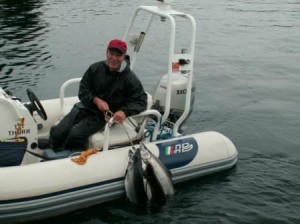
From late May to mid August millions red salmon return to the Upper Cook Inlet and can be found in the Kenai, Kasilof and Russian Rivers. Red salmon will travel along the river banks on their migration upstream and will school up in slack water areas to rest. Sockeye will splash and roll on the journey so keep an eye out for those splashes. There is definitely a technique to catching this salmon by fly fishing or using conventional gear. The red salmon swims with its mouth in continual open and close motion, so the technique involves getting the attractor as close to the mouth of the fish as possible. In shallow water and particularly over gravel bars a pair of polarized sunglasses is very helpful. Whether you use a spin fishing or conventional tackle or a fly rod the most effective attractors are a Coho, Streamer or Russian River fly or some variation of these patterns with a #3 or #4 hook with just enough weight ahead of the fly to get to fish depth. When casting , begin at an angle upstream of the spot you are fishing and try to keep the attractor broadside to the fish. when you feel a slight hesitation or bump you must set the hook immedately or you will miss. Sockeye generally lightly mouth the fly and let go. Once you begin to perfect this technique and hook one of these beauties, you are in for a wild battle of wild leaps and reel smoking up and downstream runs. Once you master the technique you will find it useful for catching the Alaska king salmon particularly on the Kasilof and Ninilchik Rivers
In August Red Salmon return to Resurrection River, at the Head of Resurrection Bay, in Seward Alaska. Locals and visitors to Seward Alaska, can limit out daily while fishing from shore or wading into the brackish water at the head of the bay.
Eshamy Bay home of Eshamy Bay lodge (www.eshamybaylodge.com) boasts the largest natural run of Red Salmon in the Prince William Sound outside the Coghil, and Copper River distincts.
The mighty Copper River is one of the longest and most rugged rivers in Alaska. Twisting and cutting deeply through the Wrangell and Chugach mountains, it’s 300 mile stretch of pristine glacier-fed waters are riddled by hundreds of rapids. Every May, around the 15th, the first salmon of the season return to the rivers and streams of Alaska with the Copper River being one of the first. King, Sockeye, and Silver salmon embark on long journeys up the Copper River to spawn and lay their eggs. As salmon begin their last journey up this home stretch and prepare to mate, their feeding habits diminish. Because the Copper River salmon’s journey is so long, they must store extra fat and oils in order to survive the long trip. This high fat and oil content is why Copper River salmon are recognized as some of the world’s best eating salmon.
Copper River salmon are bright silvery salmon with a bright red flesh, a firm texture, and a rich flavor that makes them a very delicious dining experience whose popularity is rapidly growing. Hundreds of fishermen try their luck, flooding the local Alaskan fishing town of Cordova in a “salmon rush” frenzy. The 500 some gill-netters fish the 35 -mile wide Copper River Delta(mouth) where depth and sandbars change yearly. The rushing waters of the Copper River empty steeply from the mountains above while breakers pound in from the ocean. Parralled with unpredictable weather and tides makes fishing the “Flats” of the Copper River a bit dangerous at times. But the catch is well worth it.
For the fisherman, catching 100 sockeye in a set is okay, but 400 is outstanding. There are tales of catches bearing as much as 700 fish! One of the reasons Copper River salmon are so prized is that the salmon are handled very carefully when caught, being bled and dressed immediately, put on ice and shipped out fresh.
The first fish are tendered and rushed back to Cordova where “salmon-thirty-salmons”, as locals call them, quickly fly directly to Seattle and off-load the fish to distribute them into markets and restaurants The Copper river delta area also has millions of Red salmon returning every spring, producing some of the finest salmon available in fish markets through out the world at that time.
Adults migrate from a marine environment into freshwater streams and rivers or lakes of their birth in order to mate (called anadromy). They spawn only once and then die (called semelparity). Sockeye salmon exhibit a wide variety of life history patterns that reflect varying dependency on the freshwater environment. With the exception of certain river-type and sea-type populations, the vast majority of sockeye salmon spawn in or near lakes, where the juveniles rear for 1 to 3 years prior to migrating to sea. For this reason, the major distribution and abundance of large sockeye salmon stocks are closely related to the location of rivers that have accessible lakes in their
Most sockeye salmon stay at sea for two years, returning to spawn in their fourth year, but some may be five or six years old when they spawn.
Distribution
On the Pacific coast, sockeye salmon inhabit rivers in, marine, and lake environments from the Klamath River and its tributaries north and west to the Kuskokwim River in western Alaska. As they generally require lakes for part of their life cycle, their distribution in river systems depends on the presence of usable lakes in the system, and thus can be more intermittent than for other Pacific salmon. On the Asian side of the Pacific Ocean, sockeye salmon are also found from the Anadyr River in Siberia south to Hokkaido, Japan
Halibut
(Book your trip to Fish Seward)
Halibut is of the genus Hippoglossus and is of the flounder family. The name halibut is derived form haly (Holy) and butt (flat fish), from its popularity as a meal religious holydays. The Pacific Halibut, Hippoglossus stenolepis, is a flat fish whose width is about one third of its length. Halibut are gray-black on the top side with an off-white underbelly. This color scheme disguises halibut from above (blending with the ocean floor) and from below (blending into the light from the sky) and is known as countershading. Both eyes are configured to the topside, and with this blending of camouflage it lies safely on the bottom away from predators. In most ecosystems the halibut is near the top of the marine food chain. In the waters nearby Seward Alaska their only common predators are the sea lion (Eumetopias jubatus), the orca (Orcinus orca), and the salmon shark (Lamna ditropis). Halibut spawn during the winter months in deep water and then pursues migratory patterns as it feeds on other fishes and invertebrates. Halibut range from Santa Barbara, CA to Nome, AK and from the Gulf of Anadyr, Russia to Hokkaido, Japan.
The average halibut weighs 20-30 lbs. The fishing fleet that departs Seward Harbor, Seward Alaska daily during May-September often returns with much larger fish. As recently as June 15, 2010 the Charter guest, Aaron Buscher, booked on Crackerjack Charters, by Hotel Seward, landed a 338 lb monster halibut, taking three men to boat the fish. Don’t expect to catch a fish this size when fishing Resurrection Bay and the nearby Gulf of Alaska waters, but don’t rule it out either. The International Game Fish Association world record halibut is 496 lbs and there have been documented commercial catches in Alaska of halibut weighing over 600 lbs.
Share On:
